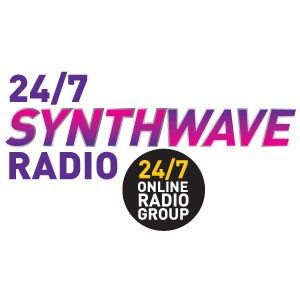
Synthwave (also called outrun, retrowave, or futuresynth[5]) is an electronic music microgenre that is based predominately on the music associated with action, science-fiction, and horror film soundtracks of the 1980s.[2] Other influences are drawn from that decade’s art and video games.[3] Synthwave musicians often espouse nostalgia for 1980s culture and attempt to capture the era’s atmosphere and celebrate it.[7]
The genre developed in the mid-to late 2000s through French house producers, as well as younger artists who were inspired by the 2002 video game Grand Theft Auto: Vice City. Other reference points included composers John Carpenter, Jean-Michel Jarre, Vangelis (especially his score for the 1982 film Blade Runner), and Tangerine Dream. Synthwave reached wider popularity after being featured in the soundtracks of the 2011 film Drive (which included some of the genre’s best-known songs) and the 2010s Netflix series Stranger Things.
Characteristics and related terms

Synthwave is a microgenre[8] of electronic music[1] that draws predominantly from 1980s films, video games, and cartoons,[9] as well as composers such as John Carpenter, Jean-Michel Jarre, Vangelis, and Tangerine Dream.[10][11][12][text–source integrity?] Other reference points include electronic dance music genres including house, synth, and nu-disco.[13] It is primarily an instrumental genre, although there are occasional exceptions to the rule.[14] Common tempos are between 80 and 118 BPM, while more upbeat tracks may be between 128 and 140 BPM.[15]
“Outrun” is a synonym of synthwave that was later used to refer more generally to retro 1980s aesthetics such as VHS tracking artifacts, magenta neon, and gridlines.[14] The term comes from the 1986 driving arcade game Out Run, which was known for its soundtrack that could be selected in-game.[16] According to musician Perturbator (James Kent), outrun is also its own subgenre, mainly instrumental, and often contains 1980s clichéd elements in the sound such as electronic drums, gated reverb, and analog synthesizer bass lines and leads – all to resemble tracks from that time period.[17]
Other subgenres include dreamwave, darksynth, and scifiwave.[6] Journalist Julia Neuman cited “outrun”, “futuresynth”, and “retrowave” as alternative terms for synthwave[5] while author Nicholas Diak wrote that “retrowave” was an umbrella term that encompasses 1980s revivalism genres such as synthwave and vaporwave.[14]
Origins
Synthwave originates from the mid-2000s[18] or late 2000s.[4] Diak traced the genre to a broader trend involving young artists whose works drew from their childhoods in the 1980s. He credited the success of the 2002 video game Grand Theft Auto: Vice City with shifting “attitudes toward the ’80s … from parody and ambivalence to that of homage and reverence”, leading directly to genres such as synthwave and vaporwave.[14]
Among the first synthwave artists were the French acts David Grellier (College), Kavinsky, M83, and Justice. These early artists began creating music inspired by famous 1980s score composers; music which was, at the time, largely associated with French house.[5] Other key reference points for early synthwave included the 1982 film Blade Runner (both the soundtrack and the film itself), 8- and 16-bit video games, 1980s jingles for VHS production companies, and television news broadcasts and advertisements from that era.[4]
Popularity and spin-offs
In the early 2010s, the synthwave soundtracks of films such as Drive and Tron: Legacy attracted new fans and artists to the genre.[6] Drive featured Kavinsky’s “Nightcall” and, with College, “A Real Hero“, which catapulted synthwave into mainstream recognition and solidified its stature as a music genre.[4] The genre’s popularity was furthered through its presence in the soundtracks of video games like Far Cry 3: Blood Dragon, as well as the Netflix series Stranger Things, which featured synthwave pieces that accommodated the show’s 1980s setting.[4] Nerdglow‘s Christopher Higgins cited Electric Youth and Kavinsky as the two most popular artists in synthwave in 2014.[19]
In the mid-2010s, fashwave (a portmanteau of “fascist” and “synthwave”)[20] emerged as a largely instrumental fusion genre of synthwave and vaporwave, with political track titles and occasional soundbites.[21] Elsewhere, there was a growing trend of Russian synthwave musicians whose work espoused nostalgia for the Soviet Union, sometimes described as “Sovietwave“.[24]
Synthwave remained a niche genre throughout the 2010s. Writing in 2019, PopMatters journalist Preston Cram said, “Despite its significant presence and the high level of enthusiasm about it, synthwave in its complete form remains a primarily underground form of music.”[4] He added that “Nightcall” and “A Real Hero” remained “two of only a small number of synthwave songs produced to date that widely known outside the genre’s followers.”[4] In 2020, “Blinding Lights“, a synthwave song by the Weeknd,[25] topped US record charts, the first song to do so during the COVID-19 pandemic.[26]
Our station, 24/7 Synthwave Radio also plays a Nightime Bar Synthwave sub-genre which we call BarSynth.
See also
- The Rise of the Synths – 2019 synthwave documentary featuring John Carpenter[27]
- 1980s in music
- Cyberspace
Notice: Text is available under the Creative Commons Attribution-ShareAlike License; additional terms may apply. By using this site, you agree to the Terms of Use and Privacy Policy. Wikipedia® is a registered trademark of the Wikimedia Foundation, Inc., a non-profit organization.
